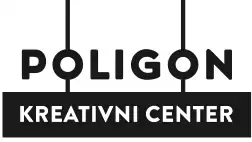Poligon kreativni center | |
 | |
| Formation | February 17, 2014 |
|---|---|
| Dissolved | December 1, 2019 |
| Location | |
| Coordinates | 46°02′48″N 14°29′07″E / 46.046722°N 14.485378°E |
| Website | poligon |
Poligon Creative Centre (Slovene: Poligon kreativni center, commonly known as Poligon) was a creative centre in Slovenia and the first and largest coworking space in Slovenia.[1][2][3][4] It was a training ground for creative communities and self-employed operating in the field of creative economies, social entrepreneurship and culture in Ljubljana, Slovenia, and it was placed inside the former tobacco factory, Tobačna Ljubljana.[5][6][7] The Slovenia Crowdfunding Initiative was based out of the center.[8]
History
Poligon was established in February 2014[9] by Slovenia Coworking (Luka Piškorič, Eva Perčič, Marko Orel) - national initiative for popularization of coworking in Slovenia with the help of supporting communities: Slovenia Crowdfunding, Kreativna cona Šiška, and Ljudje.si.
Poligon was created with the goal of promoting opportunities for self-employment of creative professionals in Ljubljana.[8] Poligon offered a coworking space for its community, makerspace, a crowdfunding lab, a classroom, a bar, a library, a gallery space, and organised many social and cultural events. It was part of the international coworking exchange program in cooperation with coworking spaces across Europe.[3]
Poligon was run by their three co-founders Piškorič, Orel, and Perčič (Matjaž).
Poligon ceased all of its operations 2019.[10]
Facilities
Poligon's space is 1200m2.[11] Besides offering a workspace, Poligon also holds workshops for self-employed entrepreneurs and makers, exhibitions as well as social events.[12]
Notable events
Since its founding, Poligon has had a positive impact on the creative sector in Slovenia.[13]
In 2015, Poligon was featured as part of the Remote Year program.[14]
References
- ↑ Košak, Lemen (2 June 2015). "Premalo radikalno: Prostor za prekarne delavce bo še obstajal". Mladina. No. 6. Retrieved 26 June 2016.
- ↑ Gabrijan, Pina (December 2015). "Future Perfect: Training Ground for Creative Communities". Goethe-Institut. Retrieved 26 June 2016.
- 1 2 "Poligon, ki v državo privablja milijone, pred zaprtjem: Središče za sodelo in množično financiranje". Radio-Television Slovenia. 7 February 2015. Retrieved 26 June 2016.
- ↑ STA (23 September 2015). "Old Ljubljana Tobacco Factory Turning into New Art Centre". The Slovenia Times. Retrieved 26 June 2016.
- ↑ Košak, Klemen (21 March 2016). "Pisarna za prekarce: Coworking je odziv na razmah ustvarjalnega in prožnega dela". Mladina. No. 12. Retrieved 26 June 2014.
- ↑ "V ljubljanski Tobačni zaživel prvi slovenski kreativni center Poligon". Siol. 13 February 2014. Retrieved 26 June 2016.
- ↑ Krajčinović, Nina (22 February 2012). "Poligon, vadbišče za samozaposlene profesionalce". Delo. Retrieved 26 June 2016.
- 1 2 Mesku, Melissa (17 July 2014). "Creating value through crowdfunding and collaboration". New Worker Magazine. Retrieved 26 June 2016.
- ↑ Kranjec, Mankica (16 February 2012). "Jutri bo zaživel prvi slovenski kreativni center Poligon". Delo. Retrieved 26 June 2016.
- ↑ "Poligon Alarko Servis ..444"1"494.. Alarko Poligon Servis Özel Tamir Servisi". 2012-03-15. doi:10.4016/46042.01.
{{cite journal}}: Cite journal requires|journal=(help) - ↑ "Poligon Creative Centre". Culture of Slovenia. Retrieved 26 June 2016.
- ↑ Perčič, Eva (3 June 2014). "Poligon, The First Creative Centre in Slovenia: Coworking Movement Plays A Key Role In The Times Of Increasing Precarious Work". Kreazin. No. 1. Retrieved 26 June 2016.
- ↑ Gray, Amanda (15 April 2015). "Take Five: The Creative Side of Ljubljana, Slovenia". Paste. Retrieved 26 June 2016.
- ↑ "Not Alone... In Ljubljana". Remote Year. 6 July 2015. Retrieved 26 June 2016.
External links
 Media related to Poligon Kreativni Center at Wikimedia Commons
Media related to Poligon Kreativni Center at Wikimedia Commons- Official website
This article incorporates text from the Culture.si entry "Poligon Creative Centre", licensed under the Creative Commons Attribution-ShareAlike 3.0 Unported License. The text was retrieved on 26 June 2016.